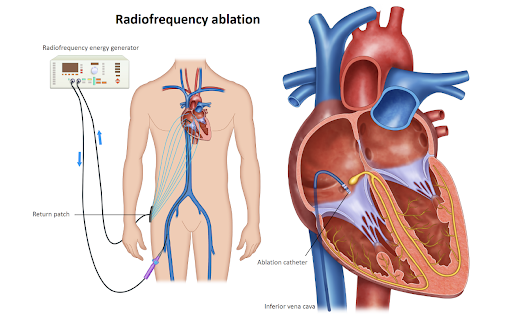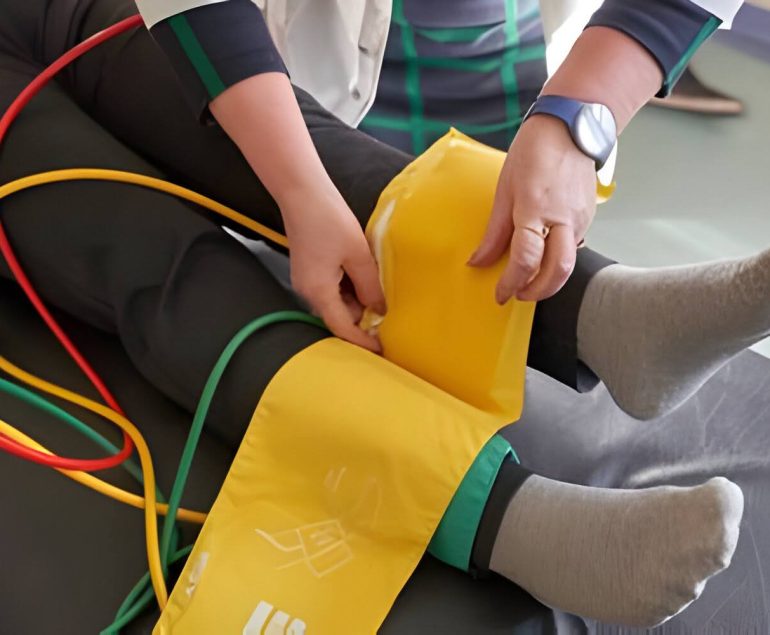Cardiac arrhythmia ablation, also known as catheter ablation, is a minimally invasive procedure used to treat certain types of abnormal heart rhythms or arrhythmias by selectively destroying or isolating abnormal electrical pathways in the heart. It involves inserting catheters into the heart to deliver energy (such as radiofrequency or cryotherapy) to targeted areas responsible for initiating or sustaining arrhythmias, with the goal of restoring a normal heart rhythm and reducing symptoms.
Procedure
During a cardiac arrhythmia ablation procedure, the patient is typically sedated or under general anesthesia to minimize discomfort and reduce the risk of movement during the procedure. The procedure is performed in a specialized cardiac electrophysiology laboratory (EP lab) by a team of cardiac electrophysiologists and nurses. The following steps outline the general process of cardiac arrhythmia ablation:- Preparation: The patient’s vital signs, including heart rate, blood pressure, and oxygen saturation, are monitored continuously throughout the procedure. Electrodes or patches are placed on the patient’s chest to monitor cardiac rhythm and deliver electrical energy if needed.
- Access: The cardiologist inserts one or more catheters (thin, flexible tubes) into a blood vessel, usually in the groin or neck, using a small needle and guide wire. Local anesthetic is applied to numb the insertion site.
- Guidance: The catheters are advanced through the blood vessel and guided to the heart using X-ray imaging (fluoroscopy) and, in some cases, three-dimensional mapping systems. This allows the cardiologist to position the catheters in specific areas of the heart and identify abnormal electrical pathways responsible for the arrhythmia.
- Mapping: Once the catheters are positioned within the heart, they are used to create a detailed map of the heart’s electrical conduction system and identify the location of the arrhythmia substrate, such as abnormal electrical pathways, focal sources, or areas of scar tissue.
- Ablation: Once the abnormal electrical pathways or arrhythmia substrate are identified, the cardiologist delivers energy (such as radiofrequency ablation, cryoablation, or laser ablation) through the catheters to selectively destroy or isolate the abnormal tissue responsible for initiating or sustaining the arrhythmia. The energy creates small scars or lesions that disrupt the abnormal electrical pathways and restore a normal heart rhythm.
Uses of Cardiac Arrhythmia Ablation
Cardiac arrhythmia ablation is used for various diagnostic and therapeutic purposes, including:- Treating Supraventricular Arrhythmias: Ablation is used to treat supraventricular arrhythmias such as atrial fibrillation, atrial flutter, atrial tachycardia, and Wolff-Parkinson-White (WPW) syndrome by targeting abnormal electrical pathways in the atria or atrioventricular node.
- Treating Ventricular Arrhythmias: Ablation may be used to treat ventricular arrhythmias such as ventricular tachycardia or premature ventricular contractions (PVCs) by targeting abnormal electrical foci or scar-related reentrant circuits in the ventricles.
- Preventing Recurrence: Ablation aims to prevent recurrence of arrhythmias and reduce the need for antiarrhythmic medications or implantable devices (such as pacemakers or implantable cardioverter-defibrillators).
Risks and Considerations
Cardiac arrhythmia ablation is generally safe, but it carries some risks and considerations, including:- Bleeding: Bleeding or hematoma at the insertion site is a common complication of ablation procedures.
- Vascular Injury: Rarely, ablation procedures can cause injury to blood vessels, leading to bleeding, hematoma, or pseudoaneurysm formation.
- Arrhythmia Recurrence: Ablation may not be successful in eliminating arrhythmias in all cases, and arrhythmias may recur after the procedure.
- Complications: Ablation procedures carry a risk of complications such as cardiac perforation, tamponade, stroke, or damage to surrounding structures in the heart.



